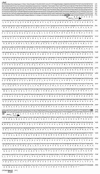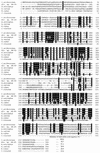Genetic analysis of Comamonas acidovorans polyhydroxyalkanoate synthase and factors affecting the incorporation of 4-hydroxybutyrate monomer
- PMID: 9726894
- PMCID: PMC106744
- DOI: 10.1128/AEM.64.9.3437-3443.1998
Genetic analysis of Comamonas acidovorans polyhydroxyalkanoate synthase and factors affecting the incorporation of 4-hydroxybutyrate monomer
Abstract
The polyhydroxyalkanoate (PHA) synthase gene of Comamonas acidovorans DS-17 (phaCCa) was cloned by using the synthase gene of Alcaligenes eutrophus as a heterologous hybridization probe. Complete sequencing of a 4.0-kbp SmaI-HindIII (SH40) subfragment revealed the presence of a 1,893-bp PHA synthase coding region which was followed by a 1,182-bp beta-ketothiolase gene (phaACa). Both the translated products of these genes showed significant identity, 51.1 and 74.2%, respectively, to the primary structures of the products of the corresponding genes in A. eutrophus. The arrangement of PHA biosynthesis genes in C. acidovorans was also similar to that in A. eutrophus except that the third gene, phaB, coding for acetoacetyl-coenzyme A reductase, was not found in the region downstream of phaACa. The cloned fragment complemented a PHA-negative mutant of A. eutrophus, PHB-4, resulting in poly-3-hydroxybutyrate accumulation of up to 73% of the dry cell weight when fructose was the carbon source. The heterologous expression enabled the incorporation of 4-hydroxybutyrate (4HB) and 3-hydroxyvalerate monomers. The PHA synthase of C. acidovorans does not appear to show any preference for 4-hydroxybutyryl-coenzyme A as a substrate. This leads to the suggestion that in C. acidovorans, it is the metabolic pathway, and not the specificity of the organism's PHA synthase, that drives the incorporation of 4HB monomers, resulting in the efficient accumulation of PHA with a high 4HB content.
Figures



Similar articles
-
Cloning and nucleotide sequences of genes relevant for biosynthesis of poly(3-hydroxybutyric acid) in Chromatium vinosum strain D.Eur J Biochem. 1992 Oct 1;209(1):135-50. doi: 10.1111/j.1432-1033.1992.tb17270.x. Eur J Biochem. 1992. PMID: 1396692
-
Improved production of poly(4-hydroxybutyrate) by Comamonas acidovorans and its freeze-fracture morphology.Int J Biol Macromol. 1999 Jun-Jul;25(1-3):79-85. doi: 10.1016/s0141-8130(99)00018-5. Int J Biol Macromol. 1999. PMID: 10416653
-
Physiology and molecular genetics of poly(beta-hydroxy-alkanoic acid) synthesis in Alcaligenes eutrophus.Mol Microbiol. 1991 Mar;5(3):535-42. doi: 10.1111/j.1365-2958.1991.tb00725.x. Mol Microbiol. 1991. PMID: 2046547 Review.
-
Poly-beta-hydroxybutyrate biosynthesis in Alcaligenes eutrophus H16. Characterization of the genes encoding beta-ketothiolase and acetoacetyl-CoA reductase.J Biol Chem. 1989 Sep 15;264(26):15293-7. J Biol Chem. 1989. PMID: 2670935
-
Poly(3-hydroxybutyrate) synthesis genes in Azotobacter sp. strain FA8.Appl Environ Microbiol. 2001 Nov;67(11):5331-4. doi: 10.1128/AEM.67.11.5331-5334.2001. Appl Environ Microbiol. 2001. PMID: 11679365 Free PMC article.
Cited by
-
A novel genetically engineered pathway for synthesis of poly(hydroxyalkanoic acids) in Escherichia coli.Appl Environ Microbiol. 2000 Feb;66(2):739-43. doi: 10.1128/AEM.66.2.739-743.2000. Appl Environ Microbiol. 2000. PMID: 10653745 Free PMC article.
-
Genetic characterization of the poly(hydroxyalkanoate) synthases of various Pseudomonas oleovorans strains.Curr Microbiol. 2005 Jun;50(6):329-33. doi: 10.1007/s00284-005-4508-7. Epub 2005 Jun 13. Curr Microbiol. 2005. PMID: 15968501
-
Poly(4-Hydroxybutyrate): Current State and Perspectives.Front Bioeng Biotechnol. 2020 Apr 3;8:257. doi: 10.3389/fbioe.2020.00257. eCollection 2020. Front Bioeng Biotechnol. 2020. PMID: 32318554 Free PMC article. Review.
-
Revelation of the ability of Burkholderia sp. USM (JCM 15050) PHA synthase to polymerize 4-hydroxybutyrate monomer.AMB Express. 2012 Aug 9;2(1):41. doi: 10.1186/2191-0855-2-41. AMB Express. 2012. PMID: 22877240 Free PMC article.
-
Production of a newly discovered PHA family member with an isobutyrate-fed enrichment culture.Appl Microbiol Biotechnol. 2022 Jan;106(2):605-618. doi: 10.1007/s00253-021-11742-9. Epub 2022 Jan 5. Appl Microbiol Biotechnol. 2022. PMID: 34985570 Free PMC article.
References
-
- Braunegg G, Sonnleitner B, Lafferty R M. A rapid gas chromatographic method for the determination of poly-β-hydroxybutyric acid in microbial biomass. Eur J Appl Microbiol Biotechnol. 1978;6:29–37.
-
- Davison J, Heusterspreute M, Chevalier N, Ha-Thi V, Brunel F. Vectors with restriction site banks. pJRD215, a wide-host-range cosmid vector with multiple cloning sites. Gene. 1987;51:275–280. - PubMed
-
- Doi Y. Microbial polyesters. New York, N.Y: VCH; 1990.
-
- Doi Y, Tamaki A, Kunioka M, Soga K. Biosynthesis of terpolyesters of 3-hydroxybutyrate, 3-hydroxyvalerate, and 5-hydroxyvalerate in Alcaligenes eutrophus from 5-chloropentanoic and pentanoic acids. Makromol Chem Rapid Commun. 1987;8:631–635.
Publication types
MeSH terms
Substances
Associated data
- Actions
LinkOut - more resources
Full Text Sources

